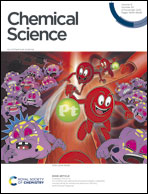Isolation of a planar 1,2-dilithio-disilene and its conversion to a Si–B hybrid 2π-electron system and a planar tetraboryldisilene†
Abstract
Lithium reagents have long played important roles in synthetic chemistry. However, unsaturated organosilicon lithium reagents are few in number. Herein, we describe the first isolation of a 1,2-dilithiodisilene: [(boryl)SiLi]2 (2) was prepared in 73% yield by the reduction of (boryl)tribromosilane (1, boryl = (HCArN)2B, Ar = 2,6-iPr2C6H3) with lithium in Et2O. The salt elimination reaction of 2 with dihaloboranes RBX2 afforded disilaborirenes [(boryl)Si]2BR (3a–c), whereas the reaction with two equivalents of B-bromocatecholborane ((cat)BBr) yielded the first tetraboryldisilene [(boryl)(cat)BSi]2 (4). X-ray diffraction analysis and density functional theory calculations indicated that the disilene 2 and tetraboryldisilene 4 feature an almost planar geometry and disilaborirenes 3a–c are aromatic with a silicon–boron hybrid 2π-electron delocalized structure. The results indicate that 1,2-dilithiodisilene 2 is a powerful synthetic reagent for the construction of novel silicon multiply bonded species with unique electronic structures and that the boryl substituents have significant electronic effects on the structure of silicon multiple bonding.



 Please wait while we load your content...
Please wait while we load your content...